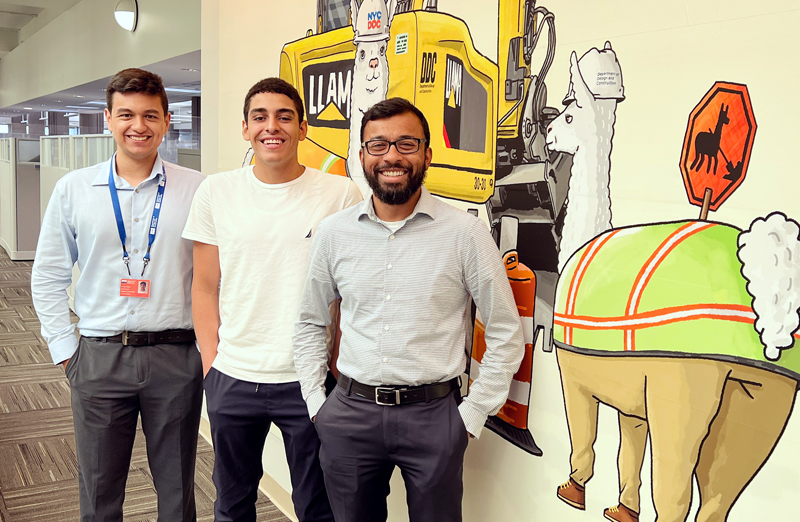
 Department of Design and Construction311
Department of Design and Construction311 Search all NYC.gov websites
Search all NYC.gov websites
DDC Summer Intern Presentations: Street Lighting and Street Furniture

On Tuesday, August 9th, 2022, DDC Infrastructure college interns Joseph Caiazzo and Omar Ebied presented on their respective projects. Joseph is studying electrical engineering at Manhattan College and Omar is pursuing a double major in Engineering and Computer Science at Swarthmore. Both students worked under the guidance of Infrastructure Senior Traffic Engineer Asheque Rahman.
Joseph presented his research on Street Lighting in NYC and gave an overview of the history of street lighting and outlined standards and guidelines and the many design challenges facing lighting infrastructure. These challenges include flooding and water damage, wind, blackouts and power outages. He explained the standards, types, and components of streetlights (base, pole, Luminaire). Joseph also discussed the impact of street lighting. Before the advent of electric lighting, other methods of emitting light for streets below were used, such as oil and gas lamps. The latter of the two were used frequently past the turn of the 20th Century when “arc lamps” lined main avenues and business streets practically over the whole length of Manhattan. After the 1930’s, street lighting as we know it was commonplace. He noted that streetlighting increases safety for pedestrians and drivers during night and dark conditions, discourages crime, and can help reinforce the character of a historic or unique district when certain specialized poles are used.
Omar’s presentation focused on the many different types of street furniture we see across the NYC streets. Omar explained that City furniture is NYC’s way of creating a comfortable, encouraging, and well-designed public environment for pedestrians. These amenities range from city benches to bus stop shelters, Citibike docking zones, bike racks, newsstands and art display cases, city street furniture for sitting or leaning bars for resting, electric vehicle chargers, LinkNYC Kiosk’s, Automatic public toilets, planters, Muni Maters, and Walk NYC Way finding. City street furniture must be durable, well designed, and visually appealing to complement its environment. Omar also analyzed and discussed the benefits and purpose that design choices have beyond aesthetics. For example, temporary flood protection devices that are deployed to reduce flood impacts on buildings, roadways and other structures are also considered street furniture, as well as waste receptacles.
Deputy Commissioner for Community Partnerships and STEAM Initiatives, Lee Llambelis, stated, “These two highly professional- and information-filled student presentations are an example of not only how much our students have learned, but they also demonstrate the tremendous effort DDC mentors have expended in sharing their knowledge and expertise with our interns.”
DDC Senior Traffic Engineer Asheque Rahman stated, “Both Joseph and Omar were fantastic interns! They came in on Day 1 with a very high level of enthusiasm and an eager desire to learn and contribute. What I appreciated most about working with them was that they took on the opportunity to expand on their experiences while allowing themselves to utilize their skill set to advance several Transportation Engineering/Construction projects in NYC. It was a great example of making an impact as an intern. We hope to have them back again as interns and later as employees.”
About the NYC Department of Design and Construction
The Department of Design and Construction is the City’s primary capital construction project manager. In supporting Mayor Adams’ long-term vision of growth, sustainability, resiliency, equity and healthy living, DDC provides communities with new or renovated public buildings such as firehouses, libraries, police precincts, and new or upgraded roads, sewers and water mains in all five boroughs. To manage this $15.5 billion portfolio, DDC partners with other City agencies, architects and consultants, whose experience bring efficient, innovative and environmentally conscious design and construction strategies to City projects. For more information, please visit nyc.gov/ddc.


